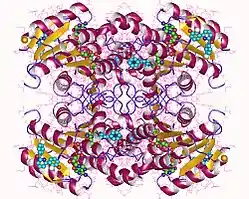HSD17B14
17β-Hydroxysteroid dehydrogenase type 14 also known as 17β-HSD type 14 or 17βHSD14 is an enzyme that in humans is encoded by the HSD17B14 gene.[5][6]
17βHSD14 catalyzes the stereospecific oxidation and reduction of the 17β carbon atom of androgens and estrogens using NAD(P)(H) as a cofactor. It is primarily expressed in glandular epithelial tissues of breast, ovary, and testis.[7]
References
- GRCh38: Ensembl release 89: ENSG00000087076 - Ensembl, May 2017
- GRCm38: Ensembl release 89: ENSMUSG00000030825 - Ensembl, May 2017
- "Human PubMed Reference:". National Center for Biotechnology Information, U.S. National Library of Medicine.
- "Mouse PubMed Reference:". National Center for Biotechnology Information, U.S. National Library of Medicine.
- Zhu Y, Imperato-McGinley JL (9 November 2016). "4.02: Disorders of Sexual Development in Males: Molecular Genetics, Epigenetics, Gender Identity, and Cognition". In Lightman S (ed.). Hormones, Brain and Behavior. 4: Clinical Important Effects of Hormones on Brain and Behavior. Elsevier Science. p. 69. ISBN 978-0-12-803608-2.
- Zanders ED (9 November 2015). Human Drug Targets: A Compendium for Pharmaceutical Discovery. John Wiley & Sons. pp. 257–. ISBN 978-1-118-84985-9.
- Sivik T, Vikingsson S, Gréen H, Jansson A (2012). "Expression patterns of 17β-hydroxysteroid dehydrogenase 14 in human tissues". Hormone and Metabolic Research = Hormon- und Stoffwechselforschung = Hormones et Métabolisme. 44 (13): 949–56. doi:10.1055/s-0032-1321815. PMID 22864907.
This article is issued from Wikipedia. The text is licensed under Creative Commons - Attribution - Sharealike. Additional terms may apply for the media files.




